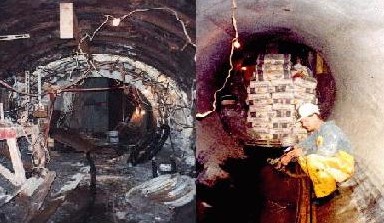Hamilton, Ontario
1995

For the construction of an underground shaft, a low strength, inflammable backfill grout had to be designed to prevent direct load transfer from a squeezing rock formation, preventing it from exerting excessive pressure on the shaft liner. The annular space between the formation and the liner needed to be filled with compressible foam with an unconfined compressive strength (U.C.S.) of less than 200 p.s.i. to avoid direct load transfer from the formation to the liner.
ECO developed lightweight cement foam that consisted of a stable foam and a stable cement based suspension grout that were mixed in a paddle mixer with a horizontal axis. The resulting very light cement foam was injected into the annular space.
The maximum “lift height” was determined with the “Sutometer” (a device in which the pressure, created by the weight of the cement foam, was simulated on cement foam of the same “age”). As the cement foam “gelled”, it developed higher resistance against compression. Since density and U.C.S. are directly related, the density of the cement foam (and hence the ultimate U.C.S.) could be calculated at any time, under actual load conditions with the Sutometer. This in turn determined the thickness of the lifts to prevent the formation of a grout that would be too strong. Alternatively, accelerators were added to increase the gel strength with time and to increase the height of each lift of cement foam.
ECO designed the grout formulation and execution method and performed site engineering as a sub-consultant to Mountainview Geotechnical Engineering.
